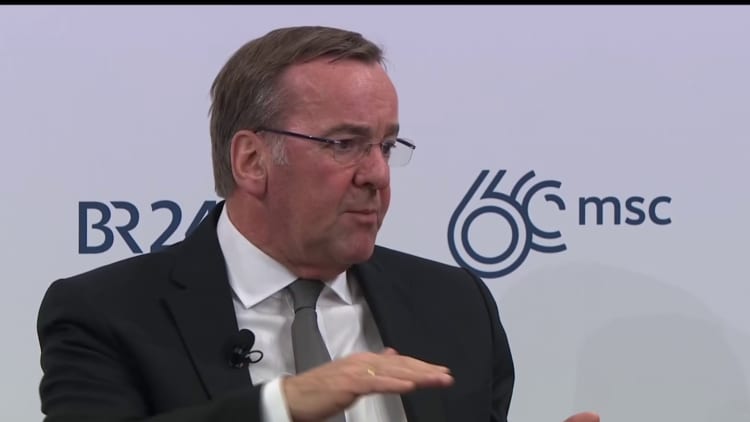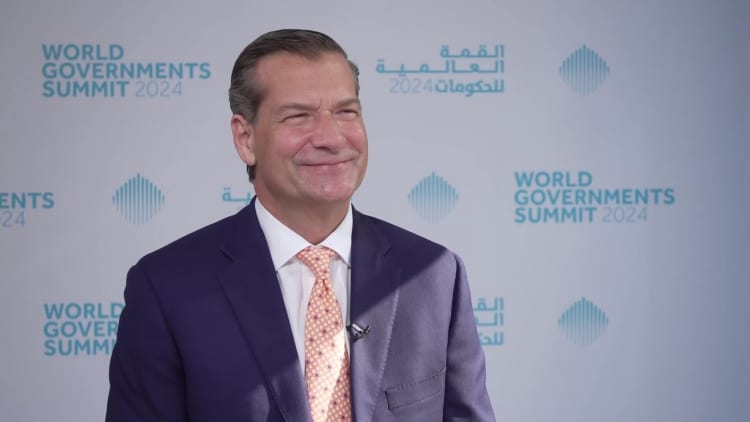French President Emmanuel Macron welcomes Ukraine’s President Volodymyr Zelenskyy and German Chancellor Olaf Scholz for a meeting at the Elysee Palace in Paris, France, February 8, 2023.
Sarah Meyssonnier | Reuters
Munich, GERMANY — Should we borrow from global markets as one combined entity and raise new debt together?
That’s the question hanging on the shoulders of EU officials as they promise to spend more on defense amid Russia’s onslaught in Ukraine.
This debate is not new — and it is historically complex.
For many years, EU nations that were traditionally more conservative over how they spend their money did not want to tap capital markets together with the rest of the bloc. They feared that ultimately their fiscal prudence would be jeopardized by other nations with looser ideas of how to spend cash.
However, in 2020, the 27 members of the European Union decided that the best way to deal with the financial and extraordinary impact of the Covid-19 pandemic was to jointly raise debt.
Now almost four years down the line, some EU officials are saying that what they did during the pandemic is a good blueprint to fund their new defense plans.
But others disagree.
“This is not the magic solution, but it could it could help actually to speed up and to expand our industrial capacity. And that is really what’s at stake today,” Alexander de Croo, Prime Minister of Belgium, told CNBC Friday on the sidelines of the Munich Security Conference, about what raising new debt could mean for Europe’s defense plans.
Estonian Prime Minister Kaja Kallas said in an interview with Bloomberg that joint bonds would be a good way to boost the bloc’s defense capacities.
But Germany’s finance minister, Christian Lindner, was very clear during a panel discussion at the Munich Security Conference this weekend: “In Brussels, it is kind [of] a spot to look for problems [and] to present always the same solution, mutualized debt.”
Instead, Lindner suggested that the EU should develop a single market for defense products, as well as promoting consolidation in the sector and pursuing the joint procurement of military goods.
Dutch Prime Minister Mark Rutte was also very clear he would not support joint debt at the EU level.
He said that in order to fund new defense spending “either you raise it at the national level or you raise [it] through [the EU’s] own resources, which has certain political and also structural disadvantages.”
“In the end, there is money coming from the people through taxation and I would say let’s do it at the national level,” he said at the MSC.
The question of how to ramp up region-wide defense spending is particularly important at this time. EU leaders feel the pressure to do more amid security threats from Russia and an uncertain outcome from the upcoming U.S. election.

Former U.S. President Donald Trump caused uproar across many European capitals earlier this month when he said he would not come to the rescue of NATO allies that were not respecting the 2% of GDP in defense spending in the event of being attacked by Russia.
His remarks were seen as potentially meaning that the U.S. may no longer be a reliable partner in respecting NATO’s Article 5 that says an attack on one member is an attack on all of them.
Many European NATO countries have missed that spending target for many years, citing financial crises and historical reasons. However, according to NATO data, 18 out of the 31 members of the defense alliance are now on track to respect that pledge this year.
Russia’s security threat, though not imminent, is also refocusing the minds of many European leaders to spend more on defense.
Danish officials have warned that Russia could attack a NATO country in three to five years. German officials have put forward a similar timeline.
Speaking at a CNBC-moderated panel in Munich, Germany’s Defense Minister Boris Pistorius said “2% can only be the start of it. We might — we’ll probably need more — in the next years.”
Credit: Source link














